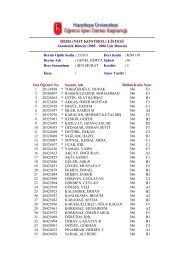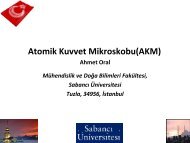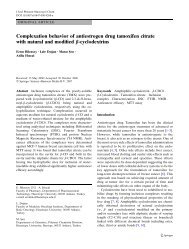Factors affecting the complexation of polyacrylic ... - ResearchGate
Factors affecting the complexation of polyacrylic ... - ResearchGate
Factors affecting the complexation of polyacrylic ... - ResearchGate
You also want an ePaper? Increase the reach of your titles
YUMPU automatically turns print PDFs into web optimized ePapers that Google loves.
2740 DUBOLAZOV ET AL.Figure 2. Convoluted emission spectrum <strong>of</strong> PAA/UO 2þ2complex in aqueous solution. k ex ¼ 310 nm,PAA/UO 2þ2¼ 2, pH ¼ 3.13. Experimental spectrum(—) obtained from UO 2þ2(---) and PAA/UO 2þ2(—)peaks.excess <strong>of</strong> UO 2þ2complex stoichiometry with nondissociatedgroups <strong>of</strong> polyelectrolyte.As <strong>the</strong> emission spectrum shown in Figure 2gives <strong>the</strong> envelope <strong>of</strong> individual peaks within <strong>the</strong>spectral range deconvolution s<strong>of</strong>tware has beenused to determine peak positions and <strong>the</strong> exactintensities <strong>of</strong> PAA/UO 2þ2spectrum. According to<strong>the</strong> changes in intensity <strong>of</strong> uranyl PAA complexband under external stimuli factors we attemptedto use <strong>the</strong> I/I 0 ratio, where I and I 0 are <strong>the</strong>luminescence intensity <strong>of</strong> PAA/UO 2þ2complexband in aqueous solution with and withoutexternally <strong>affecting</strong> factors such as, H þ or OH ,salt concentration (Na þ and K þ ), and temperature.Relative luminescence intensity <strong>of</strong> polycomplexband can serve as a qualitative evaluationcriterion <strong>of</strong> enhancement or weakening <strong>of</strong> interactionsbetween polymer and metal ions: increase<strong>of</strong> I/I 0 value can be interpreted to be asdue to a more compact structure as well as morestable. On <strong>the</strong> o<strong>the</strong>r hand, if I/I 0 value is lowerthan 1 it means that fluorescence properties <strong>of</strong>UO 2þ2species are diminished under <strong>the</strong> quenchingeffect. Contribution <strong>of</strong> both enhancement(destabilization) and quenching effect to <strong>the</strong>PAA/UO 2þ2emission spectra under external stimulieffects are separately considered later.pH EffectThe results <strong>of</strong> <strong>the</strong> previous studies showed thatchelation <strong>of</strong> metal ions by polymeric ligandsdepend on <strong>the</strong> equilibrium pH <strong>of</strong> medium. Sebastianand coworkers 24 investigated <strong>the</strong> PAA <strong>complexation</strong>with various metal ions at different pHvalues (3.45–6.0). The optimum pH for maximummetal-ion uptake by this polymer was found tobe as follows: 5.4 for Fe(III), 5.4 for Co(II), 6.2for Ni(II), 5.4 for Cr(III), and 6.4 for Zn(II). Thelimitation <strong>of</strong> pH interval was attributed to <strong>the</strong>metal hydrolysis and precipitation at higher pH.However, Bodzek et al. 25 investigated <strong>the</strong> possibility<strong>of</strong> removing Cu, Ni, and Zn ions frommodel and real galvanic wastewater at 2–10 pHregion, using PAA as flocculant. In all cases<strong>the</strong>re was an increase in <strong>the</strong> permeate flux concomitantwith increasing <strong>of</strong> pH. This phenomenonwas explained by formation <strong>of</strong> metal–PAAcomplexes more easily at higher pH.Most <strong>of</strong> <strong>the</strong> studies about <strong>complexation</strong> <strong>of</strong>UO 2þ2ions with functional group containing polymersshowed that ion exchange has been consideredas <strong>the</strong> main mechanism responsible forUO 2þ2ion separation. 26 The ion exchange mechanismfor UO 2þ2ion binding to <strong>the</strong> polymer is complicatedby <strong>the</strong> fact that <strong>the</strong> UO 2þ2ion is hydrolyzedin aqueous solutions within <strong>the</strong> pH range<strong>of</strong> <strong>the</strong> studied adsorption system and differenttype <strong>of</strong> hydrolyzed UO 2þ2ions are formed. At pH4.0, more UO 2 (OH) þ ions exist in <strong>the</strong> solution. 27Application <strong>of</strong> fluorescence spectroscopy hasbeen hampered by inconsistent interpretation <strong>of</strong>fluorescence lifetimes observed in solutions withincreasing pH. While it has been well knownthat <strong>the</strong> UO 2þ2species has a fluorescence lifetime<strong>of</strong> about 1 ls in acid solution (pH < 2), a secondlifetime contribution had been reported toappear on increasing <strong>the</strong> pH value to basic solutions.This second lifetime <strong>of</strong> about 2.5 ls hasbeen interpreted because <strong>of</strong> different fundamentalprocesses, for example, intersystem crossingor various hydrolyzed uranyl species formation.18 At pH 4, UO 2þ2is <strong>the</strong> predominant species(96%), UO 2 (OH) þ is less than 4%; at pH 5, UO 2þ2is around 69%, UO 2 (OH) þ is less than26%, (UO 2 ) 2 (OH) 2þ2is less than 5%; at pH > 5.5,<strong>the</strong> fractions <strong>of</strong> UO 2 (OH) þ (35%) and (UO 2 ) 2 (OH) 2þ2are decreased and <strong>the</strong> fraction <strong>of</strong> (UO 2 ) 2 (OH) 3þis increased with increasing pH. 28For studying <strong>the</strong> pH effect on luminescenceproperties <strong>of</strong> PAA/UO 2þ2complex we investigated1.88–4.02 pH range to avoid hydrolyzed forms <strong>of</strong>UO 2þ2. The pH dependence <strong>of</strong> <strong>the</strong> relative luminescenceintensity <strong>of</strong> <strong>the</strong> complex emission bandis shown in Figure 3a. As it can be seen from figure,I/I 0 values are lower than 1 and reachingthis value only at pH 3.25, which probablymeans that <strong>the</strong> presence <strong>of</strong> excess <strong>of</strong> H þ or OHions is unfavorable for <strong>complexation</strong> between








